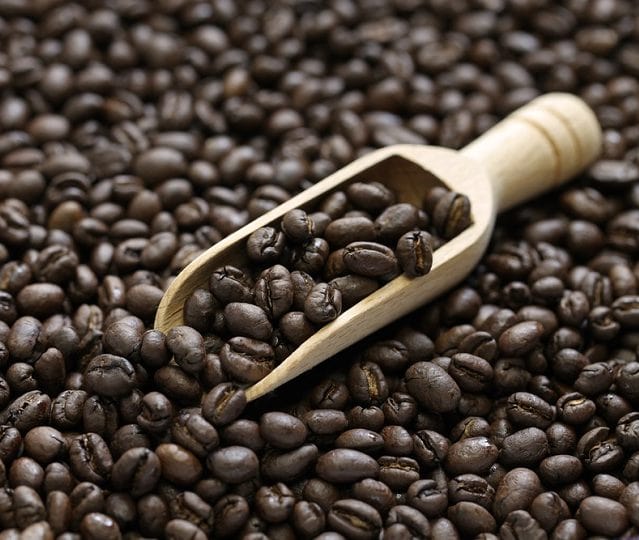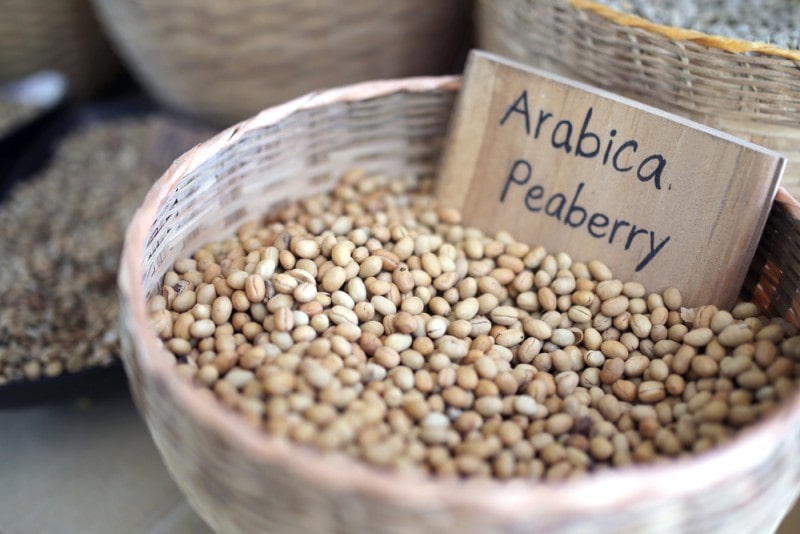
You might have seen peaberry coffee on the menu at your local coffee shop and wondered if you should give it a try. Peaberry coffee is generally expensive – often very expensive – and at first glance, it’s not obvious why. In this article, we’re going to teach you what peaberry coffee is, why it usually costs more than ordinary coffee, and how it tastes different from the regular coffee you’re used to drinking. By the end, you will be armed with all the knowledge you need to decide if dipping your toes in the peaberry pool is right for you. In short, peaberry coffee is the result of a rare genetic mutation that causes only one seed to grow instead of two.

What is Peaberry Coffee?
Peaberry coffee is a genetic mutation occurring in approximately 5-10% of coffee cherries that causes only one seed to form instead of the usual two. Coffee seeds – what we consumers call beans – usually form in pairs in the flat coffee bean shape we’re used to seeing. Peaberry seeds grow by themselves and are smaller and rounder than ordinary seeds.
An Inside Look at a Coffee Cherry
Coffee beans are seeds of the coffee fruit, analogous to more familiar seeds like apple seeds and ordinary cherry seeds. Coffee trees go through the same stages of growth as other plants, with the fruit blossoming in the latter stages of the growing cycle. Farmers harvest the coffee cherries when the fruit is mature, and the seeds are fully formed.
A mature coffee cherry contains two flat seeds side by side of roughly equal weights and sizes. The fruit is designed by nature to protect these seeds and has many layers of soft, mucous membranes surrounding them. Peaberry cherries look identical to normal, non-mutated cherries on the outside but only have one small, dense seed. Since it is impossible to tell peaberry cherries apart from ordinary coffee cherries, both are harvested together.

After harvesting, the cherries have to be processed to remove the outer layers of fruit from the seeds so the seeds can be dried and ready for roasting. A challenge unique to peaberry coffee is separating it from the regular coffee seeds. Since it is impossible to identify peaberry cherries before they’re harvested, how do farmers sort peaberry seeds?
Sorting Things Out
Since peaberry seeds are smaller and denser than regular coffee seeds, they can be separated by a machine that sorts based on size and weight. This usually works well as a first pass but also requires expensive complicated machinery. Even when machines are used to sort peaberry, a human still checks the batches by eye to verify that only peaberry seeds made it through the filtering process. Some farms sort peaberry entirely by hand, skipping the machine sort entirely.

How Does Peaberry Coffee Taste?
Now that we know what peaberry is and how coffee farmers process it, what does it taste like? Is all the effort worth it?

Peaberry coffee tends to be very bright and acidic, with high levels of sweetness and concentrated flavors. Many people describe peaberry coffee as an enhanced version of whatever bean the peaberry came from, and we like this description.
Remember, since peaberry is a genetic mutation, it can come from any origin and therefore have many different flavor characteristics. A Kenyan peaberry will taste completely different from a Colombian peaberry, just like how regular Kenyan coffee tastes different from regular Colombian coffee.
Is Peaberry Right for You?
Some people love peaberry coffee, while others think the price is too high for coffee that isn’t that much better than regular coffee. We find that people who like vibrant, acidic coffee tend to love peaberry, while people who prefer earthy, chocolatey coffee are usually not too impressed.

Origin plays an important role too. Many African coffees have excellent peaberries, and so does Hawaii’s Kona region. Both African coffee and Kona are typically bright coffees with fruity, floral flavor profiles, all features accentuated in the peaberry variety.
The primary barrier for many people is the price. Peaberry seeds only form in 5-10% of coffee cherries, making them rare and more sought after. When you combine their scarcity with the extra steps required to process them, it’s easy to see why the price is so much higher than ordinary coffee. Still, for some people, peaberry is a delicacy and worth splurging for as an occasional treat.

Final Thoughts
We hope you enjoyed this guide to peaberry coffee and have a better understanding of what it is and whether you should try it. If you like highly acidic, fruity coffee, we recommend purchasing a peaberry from your favorite region and taking it for a test spin. You’ll probably be blown away by the elevated acidity and more concentrated, powerful flavors. It is expensive, though, so we don’t recommend making a habit of buying peaberry, but every once in a while, picking up a bag of peaberry is a great treat!
Featured Image Credit: bonchan, Shutterstock















